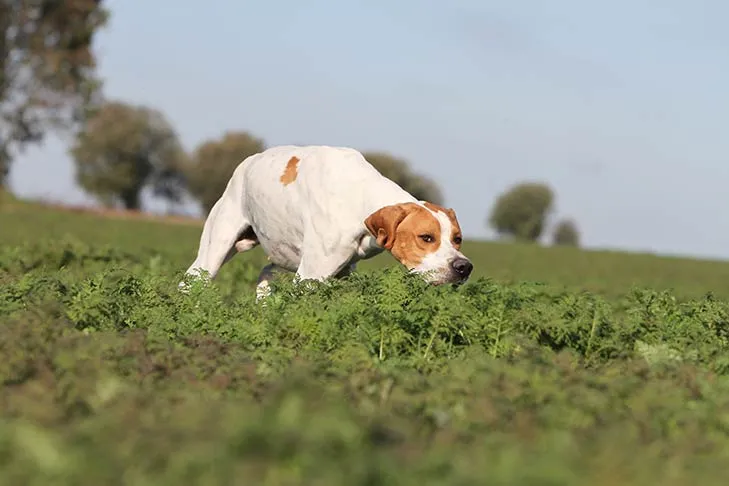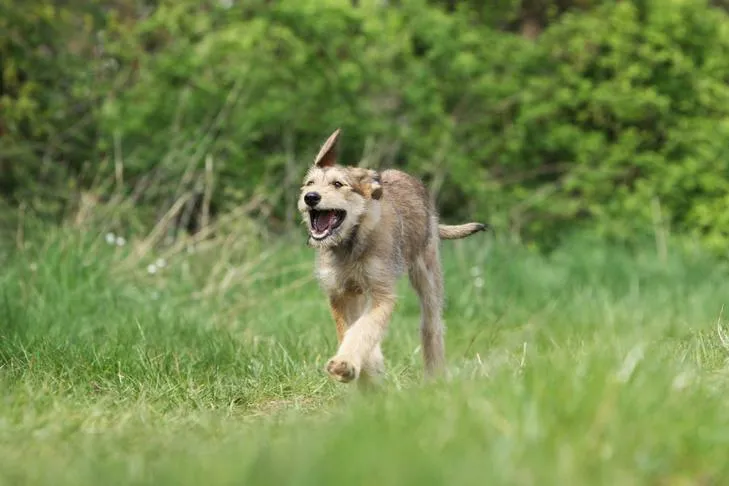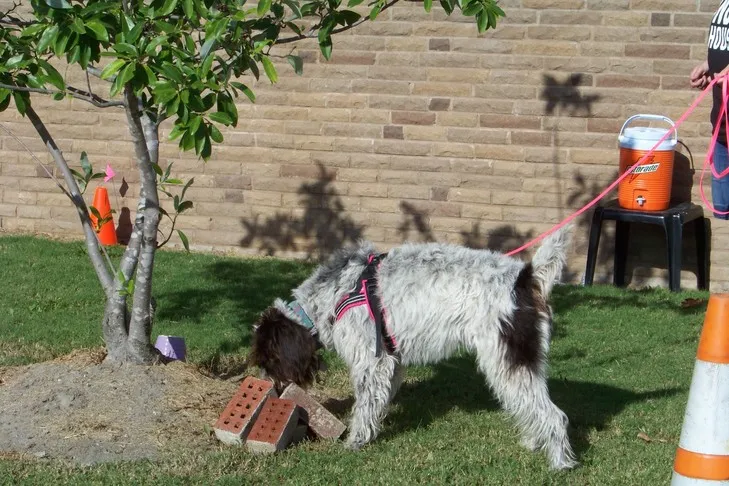Does your dog become easily distracted by passing birds, or stop listening when squirrels appear in nearby trees? A high prey drive in dogs can transform walks into challenging experiences, particularly in environments rich with temptations. Without full control over your canine companion, such situations can become dangerous for your dog, unfair to local wildlife, and significantly elevate your stress levels. Many conventional methods for how to train your dog to come off leash may not be sufficient for dogs with strong predatory instincts. These dogs often find the act of hunting so intrinsically rewarding that they will prioritize it over almost any other command. However, there are appropriate and safe approaches to managing and channeling prey drive in dogs, even when out on walks.
Understanding Predatory Behavior in Dogs
Predation is an innate, natural behavior present in all dogs to varying degrees. Breeds specifically developed for their hunting capabilities, such as Hounds, Terriers, Sporting, and Herding breeds, commonly exhibit pronounced prey drives. For some dogs, the thrill of the chase is paramount, while others are driven to catch and even dispatch their target.
Simone Mueller, a distinguished professional dog trainer and author of “Hunting Together: Harnessing Predatory Chasing in Family Dogs through Motivation-Based Training,” offers valuable insight into this complex behavior. She elaborates that “predation is a behavior chain consisting of several parts that merge into each other and that are intrinsically reinforcing for your dog. They include orientation in the environment, stalking, creeping towards prey, chasing, grab-biting, kill-biting, possessing, dissecting, and consuming.” This comprehensive understanding forms the foundation for effectively training prey drive out of your dog, or more accurately, channeling it constructively.
 A Pointer dog in a field during a hunting activity.
A Pointer dog in a field during a hunting activity.
Introducing Predation Substitute Training (PST)
Following Germany’s ban on shock collars in 2007, dog trainers developed an innovative approach to address behaviors linked to prey drive: Predation Substitute Training. This methodology centers on understanding and redirecting a dog’s natural predatory drive into alternative, appropriate outlets. Mueller describes PST as a revelation, stating, “You suddenly see the world through your dog’s eyes, and it’s a game-changer for the relationship. You’re no longer the annoying factor who spoils the fun. You’re in this together doing amazing things that your dog loves.”
She further explains that “Variations of the Predation Substitute Training protocol are a standard part of the curriculum for every science-based, force-free dog trainer in the country.” Mueller is a fervent advocate for these methods, working to raise international awareness. She contrasts this with conventional training, noting, “Conventional training programs are all about preventing or stopping the chase. Predation is ‘the enemy’ that needs to be interrupted or suppressed.” PST offers a more harmonious and effective path for Training Prey Drive Out Of Dog activities and into acceptable ones.
The PST methodology comprises four equally vital components:
1. Management and Prevention
While training can significantly mitigate a dog’s prey drive, it’s crucial to understand that you can never entirely eliminate it. The more opportunities your dog has to chase, the more they will seek the addictive thrill this provides. Consequently, robust management is a cornerstone of any successful training program. Ensure your garden is securely fenced, perhaps even reviewing how to keep dogs from jumping fence. Investing in a properly fitting dog harness and a long line is also highly recommended for safety during outings.
Setting realistic expectations is key to your dog’s success. Mueller cautions, “To be honest, Predation Substitute Training is not a magic pill you can give your dog to stop them from hunting. It is a work in progress. When you are out in an area where there are lots of predatory stimuli for your dog, please make sure to put safety first and keep them on a leash or long line.” This preventive measure is essential when actively training prey drive out of spontaneous, undesirable chasing.
2. Predation Substitution Tools
These specialized tools enable dogs to engage in “safe parts” of the predatory sequence. Mueller illustrates this with the example of chasing deer: instead of allowing your dog to chase actual deer, you can teach them to stand and stalk the deer from a safe distance. This approach allows your dog to experience the intrinsic satisfaction of the predatory sequence without posing a danger to wildlife.
“Your dog doesn’t have to abort all predatory behavior. They can still stay within the predatory sequence and enjoy the happiness hormones in their body that this action achieves,” she states. This technique is fundamental to training prey drive out of destructive behaviors by redirecting the natural instincts.
3. Predation Substitute Games
PST provides an alternative outlet for a dog’s prey drive through structured games. During these games, dogs can “mimic the parts of the predatory sequence in a safe and appropriate context.” For instance, instead of dissecting prey, they might be given the chance to enthusiastically rip apart a bag filled with dog treats. These activities satisfy their natural urges in a controlled and acceptable manner.
4. Rocket Recall
Many dog owners believe that mastering a rock-solid recall is sufficient for curbing prey-driven behavior. While recall is indeed a critical element of the solution, it is often not enough on its own. Regardless of how reliable your dog’s recall typically is, it can frequently vanish once they enter “chase mode” and the feel-good chemical dopamine is released. To enhance the likelihood of successfully calling off a dog already in pursuit, you should also develop an emergency cue. This unique word should be reserved exclusively for genuine emergencies and must always be paired with the highest-value rewards your dog treasures. Working on your dog’s impulse control is also very important here, complementing efforts in training prey drive out of dog reactions when faced with tempting stimuli.
 A Berger Picard puppy running joyfully outdoors in a field.
A Berger Picard puppy running joyfully outdoors in a field.
The Crucial Role of Self-Control
A significant component in managing prey drive is actively working on your dog’s impulse control. By requesting more calm behaviors from your dog even during exciting activities, such as playing tug, your dog gradually learns to think and process information rather than reacting instinctively and immediately to a stimulus. This cognitive pause is vital for effectively training prey drive out of automatic responses.
Healthy Ways to Channel Your Dog’s Predatory Instincts
Harnessing the specific elements of the predation behavior chain that your dog enjoys most is essential for successful management. For breeds predisposed to herding or retrieving, simply chasing a flying disc or a squeaky ball might provide sufficient outlet. You might also consider exploring dog sports such as Flyball. For breeds like terriers, offering a designated sandpit where they can dig out hidden dog toys can be a fantastic way to satisfy their natural urges. These breeds often excel in sports like Earthdog or Barn Hunt.
If your dog possesses a strong instinct for scenting and stalking, teach them what they can safely scent and stalk. Such dogs are ideal candidates for mantrailing and scent work games, as well as the sport of AKC Scent Work. These activities reinforce acceptable behaviors while fulfilling their natural drives, reinforcing the goal of train your dog to walk off leash calmly.
 A dog actively participating in a scent work competition.
A dog actively participating in a scent work competition.
By actively engaging in these types of games and activities with your dog, they will learn to associate you as an integral part of their fun. This positive association makes them far more likely to focus on you and the games you are playing, rather than chasing the neighbor’s cat or other undesirable targets, thereby aiding in training prey drive out of problematic contexts.
Why Punishment Isn’t the Solution
Simone Mueller strongly advises against the use of positive punishment methods, stating, “There are so many things that can go wrong when working with positive punishment.” Shock collars and electric fences are common tools employed to suppress predatory behaviors, but they are not infallible. Moreover, electric fences can malfunction. When a prey-driven dog is in a heightened state of arousal, they may still breach the boundary to pursue their target, enduring a painful shock in the process.
There are always kinder, equally effective training alternatives available. Mueller challenges, “Is pain really something that you want to inflict on your dog when there are less invasive forms of training available?” Ultimately, she emphasizes that techniques relying on positive punishment inflict fear and pain. If misused, such methods can lead to long-term trauma, increased aggression, and a profound breakdown of trust between you and your dog, undermining all efforts in training prey drive out of their natural instincts.
